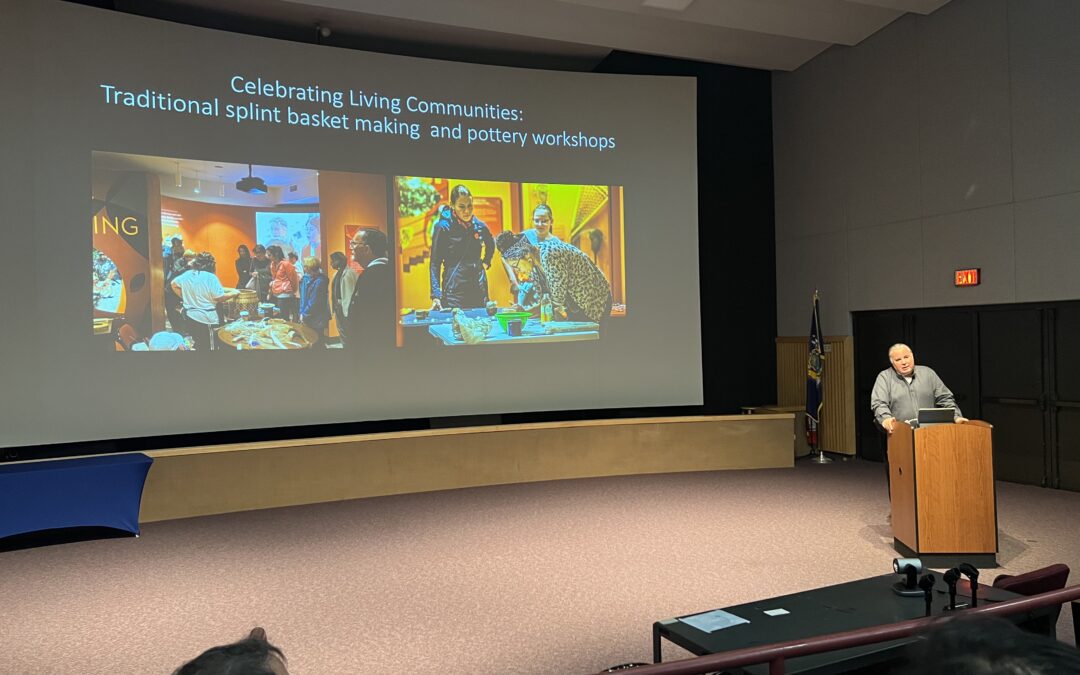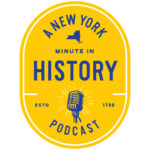
For our first episode of this new season, we’re celebrating Native American Heritage Month with a conversation regarding how historians can center authentic indigenous voices and work with Native American communities across the state in planning for the upcoming 250th anniversary of the American Revolution.
Marker of Focus: Native Voices, Chemung County
Additional markers of focus: Newtown Defense, Thick Swamp, Rowland Montour, Chemung Village
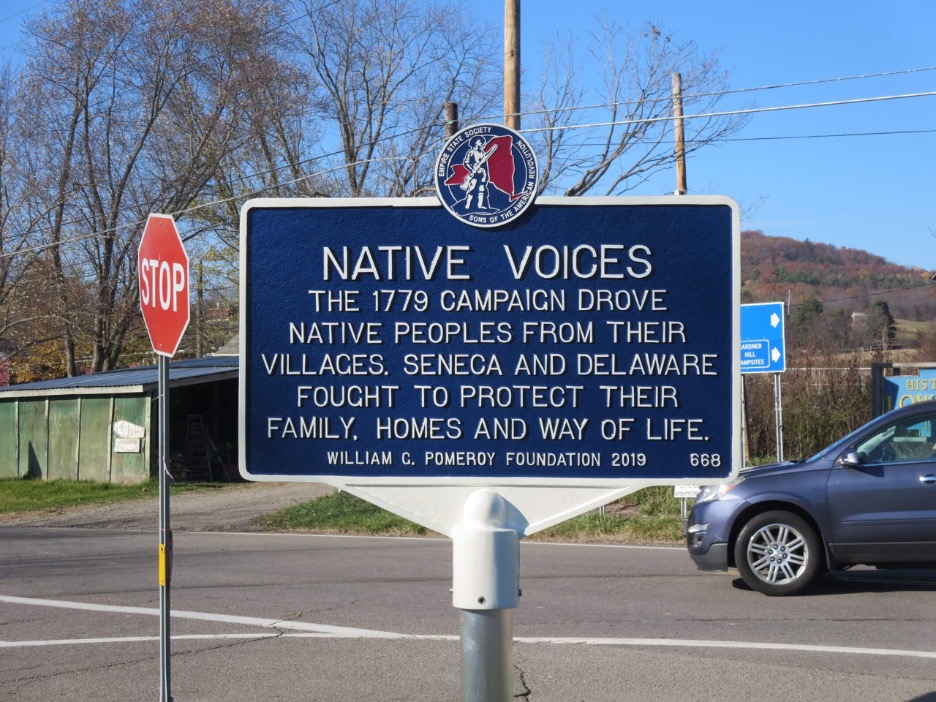
Guests: Dr. Joe Stahlman, Tribal Preservation Officer, The Seneca Nation of Indians, Dr. Nina M. Versaggi, Public Archeology Faculty, Binghamton University, Dr. Michael Jacobson, Public Archeology Faculty, Binghamton University. This episode also features parts of a public lecture given by Dr. Scott Manning Stevens at the New York State Museum on October 29th, 2023.
A New York Minute in History is a production of WAMC Northeast Public Radio and the New York State Museum, with support from the William G. Pomeroy Foundation. This episode was produced by Elizabeth Urbanczyk. Our theme is “Begrudge” by Darby.
Further Reading:
Ned Blackhawk, The Rediscovery of America: Native Peoples and the Unmaking of U.S. History.
Amy Lonetree, Decolonizing Museums: Representing Native America in National and Tribal Museums.
A. Lynn Smith, Memory Wars: Settlers and Natives Remember Washington’s Sullivan Expedition of 1779.
Scott Manning Stevens et al, Why You Can’t Teach United States History without American Indians.
Teaching Resources:
Ganondagan State Historic Site
Ramapough-Munsee Lenape Nation
Stockbridge-Munsee Community Band of Mohican Indians
Continuing Teacher and Leader Education (CTLE) Credit: The New York State Museum is an approved provider of Continuing Teacher and Leader Education (CTLE). Educators can earn CTLE credit (.5 hours) by listening to this episode and completing this survey Please allow up to two weeks to receive confirmation of completion.
Follow Along
Devin: Welcome to a new season of A New York Minute in History. I’m Devin Lander, the New York State historian.
Lauren: And I’m Lauren Roberts, the historian for Saratoga County. In honor of Native American Heritage Month, we’re going to be focusing on not one, but a series of five markers that are located in Chemung County.
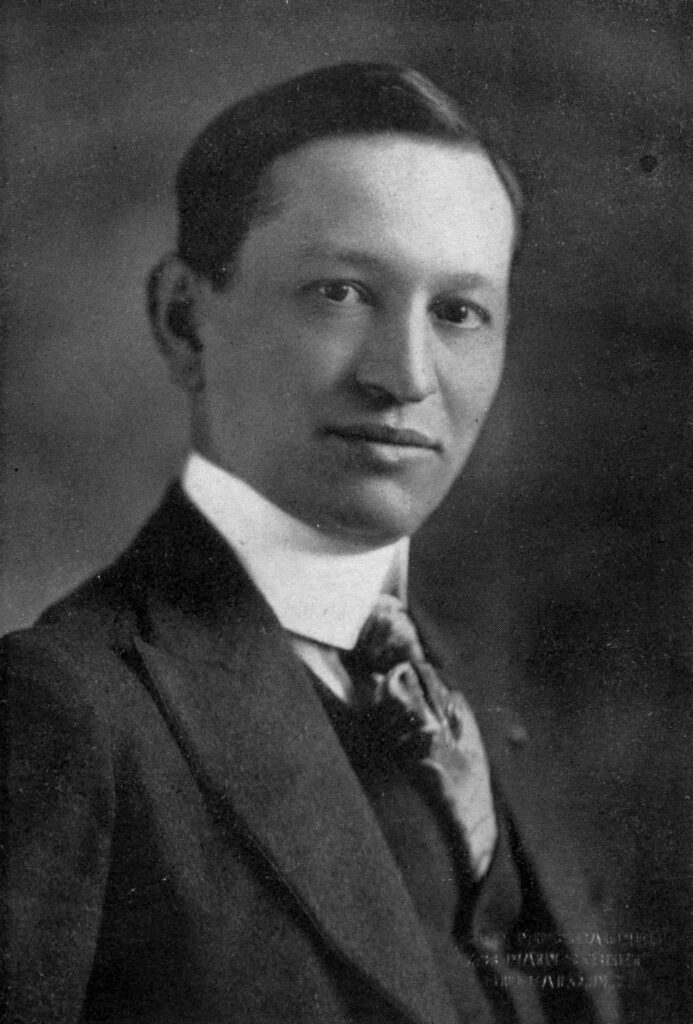
Devin: And just a little bit of background on the origins of Native American Heritage Month: interestingly enough, it can trace part of its origin to New York State, and the great Dr. Arthur C. Parker, who was a Cattaraugus Seneca. Dr. Parker was the first state archaeologist at the New York State Museum in Albany, and he went on to become the director of the Rochester Museum of Arts and Sciences. And he was also an advocate for indigenous rights. And it was through his advocacy in the early 1900s that this idea of setting aside a day to commemorate indigenous peoples really kind of began and then others kind of took it after him. And then eventually Congress passed legislation that was signed by President Obama creating Native American Heritage Day, which is the Friday after Thanksgiving.
Lauren: One of the markers in this series is entitled “Native Voices” and the text reads: The 1779 campaign drove native peoples from their villages. Seneca and Delaware fought to protect their family, homes and way of life. William G Pomeroy Foundation 2019. This marker is located adjacent to a stone marker that was erected for Newtown Battlefield and was put up in the early 1900s. The other markers are located nearby and talk about the Clinton Sullivan campaign of 1779.
The lead up to the 250th is one of the reasons that this series of five markers was erected, because it was the Delaware Nation themselves that actually reached out to the Public Archaeology Facility at [SUNY] Binghamton, which – that’s the facility that was able to get the grant for these five markers.
Dr. Nina Versaggi: I’m Dr. Nina Versaggi. I was the director of the Public Archaeology Facility on the Binghamton University campus.
Dr. Mike Jacobson: Hi, I’m Mike Jacobson, and I was the project director at the Public Archaeology Facility and I started a program focused on looking at Revolutionary War battlefields in New York State.
Dr. Nina Versaggi: I was contacted by a representative from the Delaware Nation. She asked if we would partner with the Delaware Nation, as well as other regional nations, to apply for signage as part of this program to commemorate – this as a new Pomeroy program to commemorate the 250th anniversary of the Sullivan Clinton campaign. They were a bit concerned because before the Revolutionary War, the Seneca had accepted many refugee nations to come and settle in Haudenosaunee territory.
The Delaware comprised one of those nations that came and were settled in the Chemung Valley. So the Delaware, since maybe about the early 1700s, had been residents. And these were their villages, their homeland that was in the sights of the Sullivan Clinton campaign. So they were concerned that their history here would be neglected and ignored. And so they saw this as an opportunity to have some kind of signage that recognized their presence there, and their history.
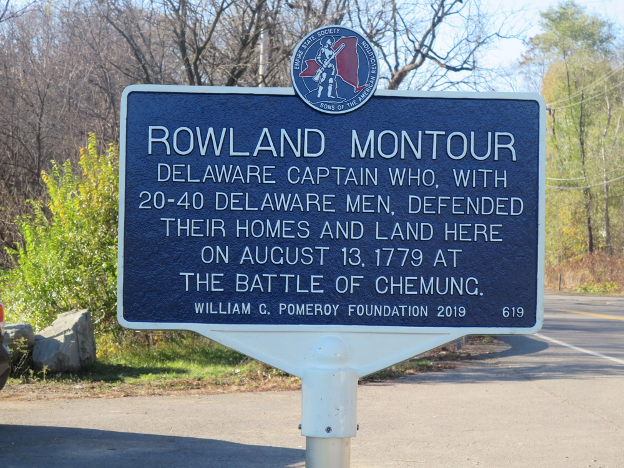
Devin: Now, just a little bit about the Clinton Sullivan campaign: what we need to remember is that at one point, all of New York State and the colony was indigenous lands. So, indigenous people who were allied with the British were conducting a series of raids along the frontier, along with their British allies. Many indigenous people, I think, were not necessarily thinking about driving people off from those people’s lands, they were thinking more along the lines of driving people off from their lands, because they had been their lands traditionally, for centuries.
So in 1778/1779, the governor of New York, George Clinton, really implored George Washington to do something about these raids. Washington gave overall command of the campaign to General John Sullivan, who was going to lead the main army up the Susquehanna River from Pennsylvania. Meanwhile, General James Clinton was moving his army westward from the Albany-Schenectady area.
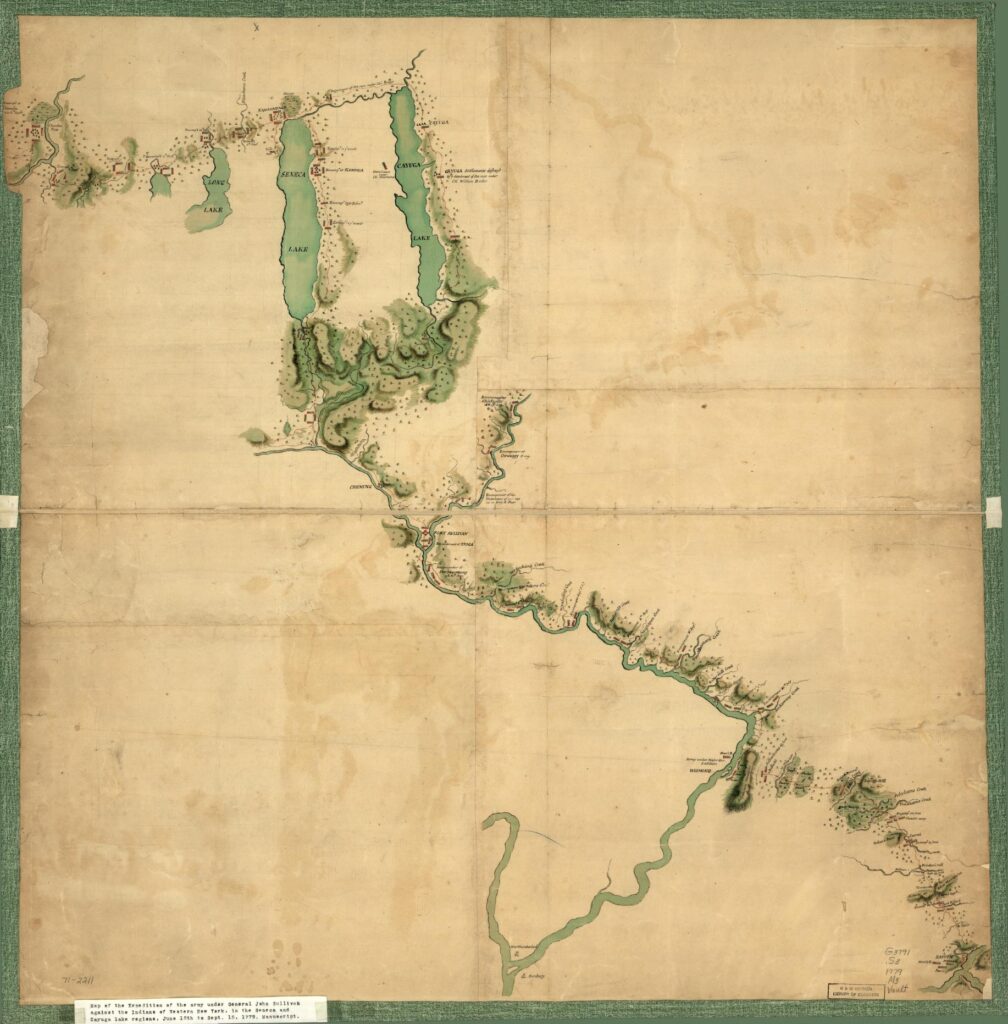
Credit: Library of Congress
Historians have argued over the years about what the actual mission was of the Clinton Sullivan campaign, but I think it’s pretty clear: The mission was to destroy the capabilities of the indigenous people, so, those allied with the British, to wage war on the frontier. To do that, the Clinton Sullivan campaign ran a rampage across indigenous lands. They were instructed to destroy villages, destroy crops, take as many prisoners as they possibly could… And there was a small battle at Chemung, but then there was a larger battle at Newtown Battlefield. And the destruction that was wrought; we’re talking a loss of an entire season’s worth of crops for people, creating mass refugees who ended up fleeing to Fort Niagara, where their British allies there did not have the supplies to help them through a very bitter, cold, Western New York winter. So, there were mass casualties as a result of that.
Dr. Nina Versaggi: Chemung County – and these two battlefields: Chemung and Newtown – they probably have the, you know, the highest number of memorials to the campaign than any other place in New York State. I can’t remember if it was twelve, or eighteen markers that had already existed. Other groups had paid for these markers, and did the text.
Part of our collaboration with the nations, mostly it was the Seneca and two Delaware Nations… So at the end, we had a conference, a summit, where we brought the Native Americans who have been collaborating with us together for further discussions and a workshop. And part of those discussions involved a tour of the battlefields as we now understood them. And it was emotional. It was hard to do. I wasn’t expecting it, but it was very emotional. And there were some tears shed when people read some of the markers that already exist. There was some graffiti on some of them, Mike?
Dr. Mike Jacobson: Yeah, if you go out there and… there’s still bronze plaques. And people had etched out some of the lettering and replaced it with statements similar to – I’m just paraphrasing – that they were defending their lands; basically, tried to input indigenous perspectives onto the landmarks that were already there.
Dr. Nina Versaggi: We involved indigenous scholars, some of them military scholars, in our projects, our grants. They wrote for our reports, first-person accounts. Our aim was to give that first-person account to indigenous peoples because only one side – for the most part – of the story of the Revolutionary War and the battlefields has been told, and so that pretty much was our aim. And it wasn’t an easy path to begin with. You say there was some reluctance. Some of the Native American groups didn’t want to talk about it at all. They thought that the wound was still open and raw and that they did not want to talk about a blood that had soaked into the ground even generations ago.
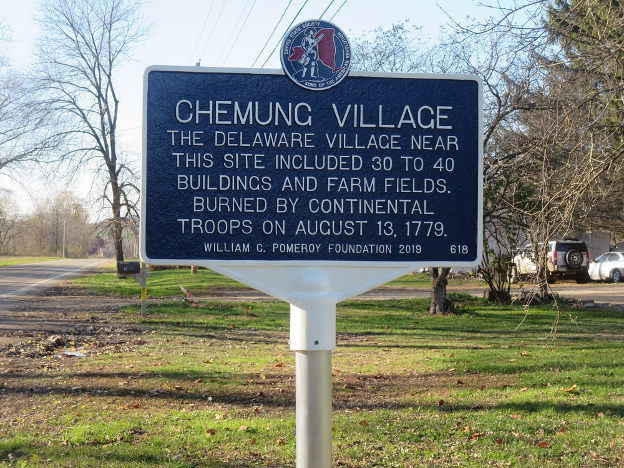
The bottom line of that tour was that we went back to discuss how the indigenous people we work with wanted to move forward. Unanimously they said, “We would like to have new signage that gives us a voice.”
But they were pretty adamant that they did not want the old ones removed. They wanted the new signage juxtaposed so that people could see the past, and how history was interpreted, and see the present and the Native American voices, giving their history with its battles. So I thought that was very interesting. And it actually makes a whole lot of sense.
So history is not static. And some of the history is pleasant, but it is what it is. And we learn from it. And we change things [unintelligible]. So they thought it was really great that they made the point that we absolutely do not want these removed, because we want people to see what it was like, and what the attitudes were, But now we want people to see what they were missing. And that’s part of the story too.
Dr Mike Jacobson: When you have sites of conflict, you obviously have lots of people that are interested in it, they’re all looking at it with their own perspective. So as we reached out and consulted with Native Americans to get their perspective, and really get their voice in this, we also reached out to the landowners, obviously, not just to get access to the land, just so we could do our research, but also just to start those discussions about possible preservation of the battlefield over the long term. And then also try to balance that perspective with other descendant communities such as the Sons of the American Revolution.
A lot of the landowners trace their history to the founders of the white settlers right after the Revolutionary War. Some of them would actually show us the land grants given to their ancestor over like, 200 years ago. So they had that pride in their family’s connection with the land.
Lauren: Commemoration is a powerful thing, because the legacy of what comes out of these commemorations tends to be what sticks in people’s mind. So as we’re getting ready for the 250th, I think it’s really important that we recognize that including source communities, the people who were part of these stories, these events, that all of their perspectives are included. We don’t want just one to rise to the top, and then that’s the only focus that people remember when it comes to the next commemoration fifty years from now.
Devin: Yeah, absolutely. And I think Dr. Versaggi and Dr. Jacobson really spoke to that about their partnerships, not only with the Sons of the American Revolution, and the Delaware Nations, but also the locals. And many of these people can trace their families back generations and maybe grew up with the old markers. And so it’s very complex to deal with this history and to think of it in a more holistic and, frankly, authentic and accurate way. But it’s something that can be done over time. And one of the ways to do that is to build relationships with all of the stakeholders. And we were able to speak with Dr. Joe Stahlman about how to build those relationships.
Dr. Joe Stahlman: My name is Dr. Joe Stahlman. I am the Tribal Historic Preservation Officer for Seneca Nation. I do a lot of consulting and writing, and a whole host of things where I talk about things that I feel like need to be addressed in certain ways to kind of re-humanize our fields of study.
The National Historic Preservation Act of 1966 set up a system where each state could have, like, State Historic Preservation offices. Within this act, you also have Tribal Historic Preservation. And so it’s kind of a twofold job. So one: you focused on your nations – the ones that you represent – their home territories, but also: these communities also have Aboriginal claims to other lands beyond their current boundaries. And so whenever there’s a development project or there’s an initiative, a natural disaster, some kind of EPA cleanups, you know, we get calls to see if there’s any cultural properties or landscapes that that tribe of interest has in those areas. And if so, we have a voice in those outcomes.
I think it works most of the time, you know, consultation can be a little rocky you know, trying to get tribal or indigenous perspectives across to federal or state agents can be a little difficult sometimes, because once again, you’re bridging worldviews. Even though we’re all considered Americans, we’re really different. So I find my job kinda important. I’m not trying to inflate my importance, but the job in itself is important because we’re helping our federal and state partners understand that there are other worldviews out there that are different from theirs. And that goes all the way from a perspective of a landscape to even a perspective in history. And so one of the things that I do in historic preservation is I try to get fair and equitable language out there. So all people kind of understand all perspectives to a story.
But when I think about roadside markers, I don’t want to go bash them down and destroy them, what I would like to do is put up an alternative marker next to it, so you have another story. And sometimes, some of the language is just abysmal, it’s shallow, it’s, it can be vapid, and not really provide anything. “Indians died here,” you know, sometimes it’s really that basic, right? Or you even have a site where it’s like: “Dug by archaeologist Steve Morris.” And there’s nothing about the people that he dug up or anything. So it’s really, you know, some of them maybe need to go, but I think, to be fair, and equitable, I think a lot of these signs, especially the American Revolution, or even the War of 1812, French and Indian, whatever, there should be other voices along the roadside with them. And I’m a firm believer in that. And it’s not about censorship, but it’s about equal voice.
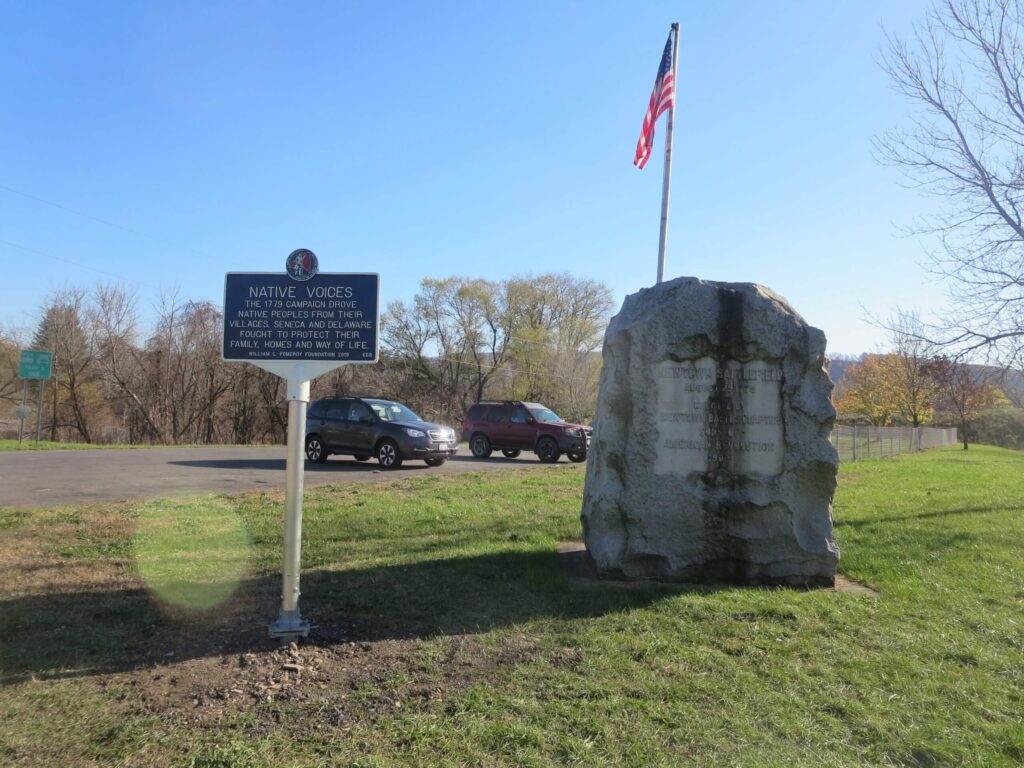
As everybody moves forward, you know, there is… I worry about word choice, though. You know, like Sullivan “Expedition” is a word that keeps popping out, the Sullivan “Expedition.” And it’s actually an invasion of foreign lands. And it’s never discussed that way. And I would like to see some road markers that talk about a foreign invasion, right? The United States has – this is its first act – as a government and they invaded a foreign country. It’s a weird thing, like, how do you go about all of this education that you were just talking about when you have to, you know, make people who now live in Yates County, New York, understand that back in 1779, that was another country. It’s hard to do in a classroom, let alone on a sign, right?
Lauren: I think we have to remember that these markers and monuments are meant to be a gateway into learning more about a subject. The four or five lines of tax that can fit in this space, are meant to pique people’s interest to let them know that something important happened on this spot. And then the hope is that it will entice them to learn more to actually go to articles, to websites, to places where there’s more options for contextualization, and learn about it further. But just that initial introduction into “history happened here” is what the markers do really well. And that’s why it’s important that we pay attention to the wording that’s on the marker, the location of the marker, and the inclusiveness of who’s telling the story on the marker.
Dr Joe Stahlman: It really starts with a phone call, and starting that relationship, and you know? Start that relationship from the beginning. Don’t develop your project, have your questions, have a methodology, and even have the expected outcomes in hand when you reach the community. You know, start at the very beginning, make it really inclusive, right? And so I get a lot of calls in my job from a lot of federal partners, mostly federal partners, and it’s open minded, well-intentioned folks who are wanting to be inclusive, but you know what? They’re calling me at a point where sometimes they have already done the analysis of the data. And they’re calling me for input at that point, I just say no, because that’s not a story about us. You just kind of… I’m just sprinkling on top of a story. And that’s not what communities are looking for, I don’t think.
You know, I think the bigger organizations who really care about history and commemorations should really reach out to as many communities as possible, it’s their responsibility. Because people don’t realize: small communities, rural communities, native communities, impoverished communities, you know, we’re busy with living life and we don’t necessarily have, you know, an army of scholars or historians out there because people are out there trying to take care of their families with, you know, something a little bit more tangible for income and, you know, being a historian is kind of a lofty, luxurious thing to have.
Devin: So much of indigenous history, at least in museums and often historic sites, is seen as something that only happened in the past, “these people exist in the past.” And this was something that we were fortunate to hear Dr. Scott Manning Stevens talk about recently at the State Museum when he gave a public lecture.
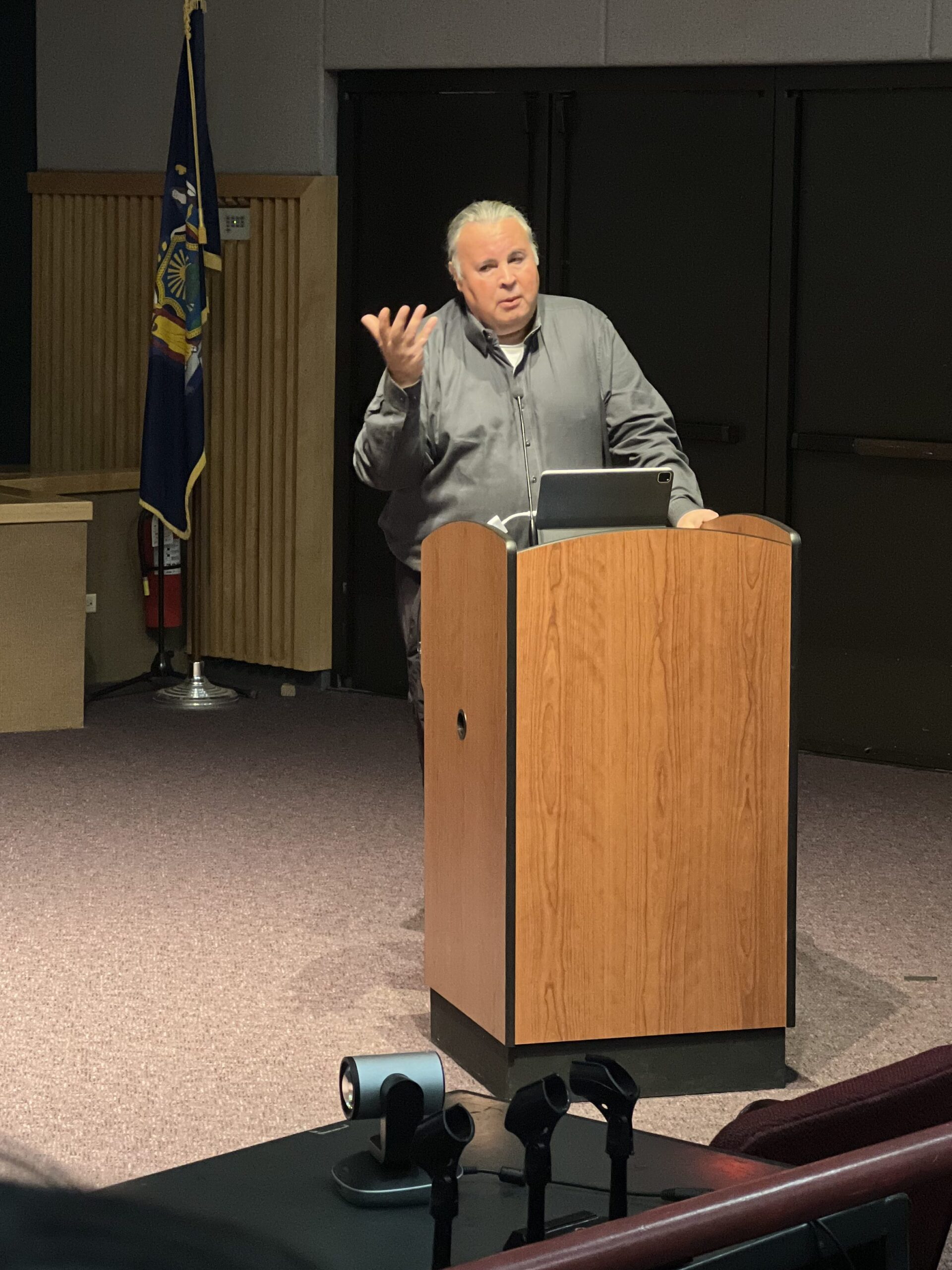
Dr. Scott Manning Stevens: I’m delighted to be here. It’s a place I have been coming – my mother reminded me – since I was four. And, I’ve had issues with it ever since then. So I thought, wow, I finally have the bully pulpit. I can talk…
As many of you know, Native Americans are most frequently coupled with natural history. Not history, natural history. So we’re always just around the corner from a dinosaur. And when I was a kid, that always struck me: Why the dinosaur? Right? Why us and the dinosaur? I don’t see anyone else with the dinosaur. Is it the presumption of things extinct? I should hope not.
Not a dinosaur here but a mastodon, same theme that you know, when I was a kid, I loved the mastodon, but I didn’t necessarily want him coupled with my mother’s people’s history. But in the old museumology, it was all about the past. You had very little indication that there were living native people in your state. You know, I’m always amazed – I teach at Syracuse, New York, right in the center of the Confederacy. And there are many students that will be like “Are there reservations in New York?” And it just makes my head explode. You know, you drive through one to get to campus! It is, you know, about four miles away. And it says when you’re on the, you know, 87 or 81, through, you know, “Onondaga Nation,” you’re driving through it, but it’s just… it’s somehow invisible to people.
Recently, I was part of a group of people that advised the Adirondack Museum – now called the Adirondack Experience – in Blue Mountain Lake. One of the things we noticed from the old building is it had no references to indigenous people… in a place called “Adirondacks.” Gee, you wonder where they got that kooky name. And yet, we were essentially invisible somehow, the Adirondacks was Indian-free. And so one of the first things we said most glaringly, is you have to include indigenous people. This was our homeland. Again, a shared space between mostly Mohawk and Abenaki people as a hunting ground, and others lived along the rivers there. And we said it also has to emphasize our contemporary presence and communities, to get us away from a museum as things in the past, as things put on the shelf, to look at and contemplate without thinking: “Now, this is actually the representation of a long term, multi generational, multi era nation that lives within this region.”
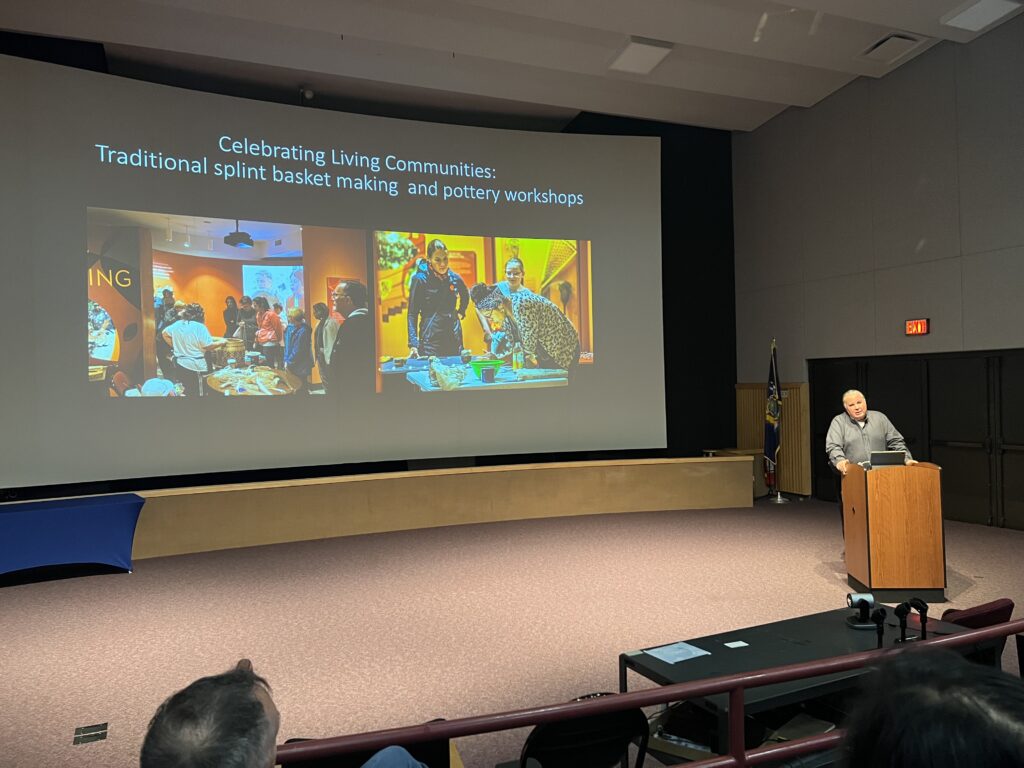
There’s a great book by the scholar Amy Lonetree – she’s a Ho-Chunk scholar, teaches out in the UC system in California – called Decolonizing Museums. And she holds up the Anishinaabe cultural center called Ziibiwing in Mount Pleasant, Michigan, as a primary example of a decolonized museum. And that’s always been, you know, a somewhat controversial notion because a lot of people will say, “You can’t decolonize museums, they are a colonial artifact in themselves.” And that goes towards the renaming of them by pivoting the focus away from artifactual collections to living cultural events. And I’ve had the fortune of going to Ziibiwing, and what I loved about it was, it is a people telling their own story. Right? Not someone else, a group of experts from outside the community telling you about them and putting their lives in vitrines and their objects there for interpretation by non-Indigenous experts. But it is the community telling you, basically, how they see themselves in the world. And how they understand their history. And it is not an easy history. As it’s not for most indigenous people. There’s you know, disease, dispossession of land, boarding schools, dispossession of culture and language. There’s substance abuse problems in endemically poor communities. The Cultural Center does not flinch from any of that. But it interprets how they understand how they got where they are. And I think every, every people represented in such institutions has the right to weigh in on how they’re being curated for the public.
Devin: All of this complex history of the Clinton Sullivan campaign, and how indigenous people have been represented in museums and historical sites and historical societies, is very much an ongoing discussion. But that’s what history is, right? Some people may think of history as a battleground. I personally think that history is a conversation. If it’s done properly, it’s a conversation that is always searching for other perspectives. And I think the 250th commemoration of the American Revolution, and the unfinished revolutions that transpired after the American Revolution really gives public historians an opportunity to think about the varying levels of New York’s history in a way that continues building upon past histories that have gone before us, some of which are not true or not accurate, are blinded by various things like racism, for example. But because of the past work and our understanding of it, we can continue to strive to complete that story. And that’s what historians do. And that’s what the commemoration, in my opinion, gives us the opportunity to do.
Dr Joe Stahlman: History is a commons. And that’s what I try to do in my job. And I’m not really pushing forward any narratives or anything at this point, it’s really I see history as kind of a commons and it should be a place that we don’t really get political and battle over. But we do. And I think that’s the shame of our field, sometimes, you know, and sometimes we get a little married to our ideologies or the narratives that we have crafted ourselves. And I think if we can just kind of look beyond it a little bit, and just appreciate that there’s other stories of the same thing that you might love. I think that might make this a little bit more inclusive. Right, and, and it also makes you feel freer to tell your own story that you might hesitate to tell.
I hope that there’s space for all of our stories, in this, and it’s never been one of censorship, it’s just one of like, “Hey, you’re not doing the same thing that I would do for you.” And I think the 250th is a great opportunity for really New York to come together. You know, I’m part of so many small networks throughout the state. And I’m just amazed by all of what New York has. I just hope that the listeners kind of go out there into the world with those kinds of eyes, I think sometimes, because: New York’s a pretty amazing place.
Devin: Thank you for listening to A New York Minute in History. This podcast is a production of WAMC Northeast Public Radio and the New York State Museum, with support from the William G. Pomeroy Foundation. Our producer is Elizabeth Urbanczyk.
Lauren: A big thanks to Dr. Scott Manning Stevens. Dr. Nina Versaggi, Dr. Michael Jacobson and Dr. Joe Stahlman for taking part in this month’s episode. To learn more about our guests and the show, check us out at wamcpodcast.org. We’re also on X and Instagram, as @NYHistoryMinute.
Devin: I’m Devin Lander,
Lauren: And I’m Lauren Roberts.
Devin: Until next time:
Both: Excelsior!
